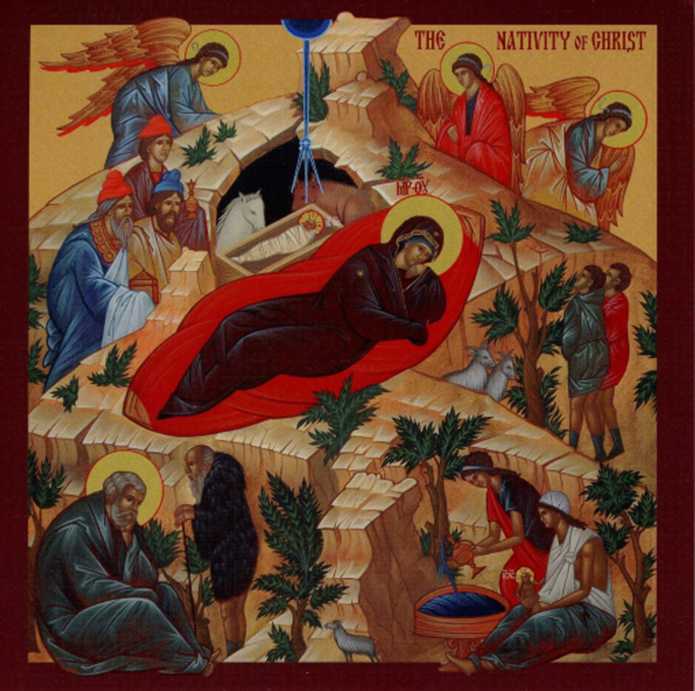The Icon of The Nativity of Our Lord

The icon of the Nativity of our Lord is packed with theology. It draws upon different sources: the Old Testament Prophecies, the New Testament Gospel accounts, and ancient narratives on the life of the Virgin Mary (The Protevangelion of James). It depicts the Creator of the universe entering history as a newborn babe: The Virgin Mary is in the center of the icon facing Joseph instead of Jesus, which is rare in any icon featuring both Jesus and Mary. She is concerned about him and interceding for him. Jesus lies next to Mary and is shown born in this dark cave, wrapped in swaddling clothes, lying in a crib. The crib at the same time represents a casket, His swaddling clothes, His burial garments, the cave, His tomb. Next to Christ, are an ox and a donkey to remind us of Isaiah 1:3. To the right, the shepherds who received from the angels the news that the Savior of the world had been born. The magi are seen to the left being guided by the star.The icon depicts the shepherds and the foreign Magi as among the first to worship Christ emphasizing that salvation is for all mankind. The women at the bottom right are midwives who display that the Son of God was truly born as a human. At the bottom left is Joseph depicted away from Jesus and the Theotokos. This is because he was not involved in the miracle of the Incarnation of the Son of God, but he was the protector of Mary and Jesus. The old man speaking to him represents the devil bringing new doubts to Joseph - a symbol of the dilemma of mankind to accept which is “beyond words or reason.” A long ray of light points to the cave: a star that shows that this event travels to all parts of the world. Lastly, the tree that is present in the icon is symbolic of the Tree of Jesse (Isaiah 11:1-2). All creation is rejoicing at the birth of the Lord: the heavens (star and angels) ; the earth (mountains, plants and animals) ; and especially mankind, represented most perfectly in the figure of the new Eve, the most pure Mother of God.
L'Icône de la Nativité de Noter Seigneur
L’ICÔNE DE LA NATIVITÉ DE NOTRE SEIGNEUR regorge de théologie. Elle s’appuie sur diverses sources : les prophéties de l’Ancien Testament, les récits évangéliques du Nouveau Testament et d’anciens récits sur la vie de la Vierge Marie (Le Protévangile de Jacques). Elle dépeint le Créateur de l’Univers entrant dans le temps historique comme un nouveau-né : Toute la composition picturale est centrée sur la grotte. C’est comme une spirale dont le point central serait ce trou sombre d’où luit la Lumière. Au centre de l’icône est la Vierge Marie qui tient une grande place dans la composition de l’icône, d’où son importance dans le mystère de l’Incarnation : Marie, par la naissance de son Fils, devient Mère de Dieu. Elle tourne le dos à l’enfant (fait rare dans toute icône représentant à la fois Jésus et Marie) et regarde avec compassion Joseph, qui est dans le doute. L’enveloppement de l’enfant dans les langes représente la soumission complète du Christ aux conditions physiques gouvernant la nature humaine. Les langes de l’enfant sont comparés aux linges enveloppant le Christ lors de Sa mort, la mangeoire ressemblant à un cercueil et la grotte préfigurant Son tombeau. L’âne et le bœuf sont issus d’une prophétie de l’Ancien Testament (Isaïe 1:3). En haut à gauche, nous voyons les trois rois mages, guidés par l’Étoile, et venant vénérer le Roi de l’Univers. À droite, nous trouvons les bergers qui ont reçu des anges la nouvelle de la naissance du « Sauveur ». L’icône représente les bergers et les mages comme les premiers à adorer le Christ, soulignant que le Salut vise l’humanité tout entière. Les femmes en bas à droite sont des sages-femmes, démontrant que le Fils de Dieu est vraiment né en tant qu’être humain. Dans l’angle inférieur gauche, Joseph est assis, accablé, la tête dans les mains, tenté par le démon du doute, sous l’aspect d’un vieux berger. Dans la personne de Joseph, l’icône ne révèle pas seulement son drame personnel, mais celui de l’humanité entière, la difficulté d’accepter à travers la raison, l’incarnation de Dieu. Un long rayon de lumière pointe vers la grotte : une étoile qui témoigne que cet événement se répand partout dans le monde. Enfin, l’arbre présent dans l’icône est symbolique de l’arbre de Jessé (Isaïe 11 : 1-2).